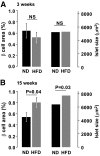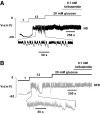Progression of diet-induced diabetes in C57BL6J mice involves functional dissociation of Ca2(+) channels from secretory vesicles
- PMID: 20150285
- PMCID: PMC2857899
- DOI: 10.2337/db09-0791
Progression of diet-induced diabetes in C57BL6J mice involves functional dissociation of Ca2(+) channels from secretory vesicles
Abstract
Objective: The aim of the study was to elucidate the cellular mechanism underlying the suppression of glucose-induced insulin secretion in mice fed a high-fat diet (HFD) for 15 weeks.
Research design and methods: C57BL6J mice were fed a HFD or a normal diet (ND) for 3 or 15 weeks. Plasma insulin and glucose levels in vivo were assessed by intraperitoneal glucose tolerance test. Insulin secretion in vitro was studied using static incubations and a perfused pancreas preparation. Membrane currents, electrical activity, and exocytosis were examined by patch-clamp technique measurements. Intracellular calcium concentration ([Ca(2+)](i)) was measured by microfluorimetry. Total internal reflection fluorescence microscope (TIRFM) was used for optical imaging of exocytosis and submembrane depolarization-evoked [Ca(2+)](i). The functional data were complemented by analyses of histology and gene transcription.
Results: After 15 weeks, but not 3 weeks, mice on HFD exhibited hyperglycemia and hypoinsulinemia. Pancreatic islet content and beta-cell area increased 2- and 1.5-fold, respectively. These changes correlated with a 20-50% reduction of glucose-induced insulin secretion (normalized to insulin content). The latter effect was not associated with impaired electrical activity or [Ca(2+)](i) signaling. Single-cell capacitance and TIRFM measurements of exocytosis revealed a selective suppression (>70%) of exocytosis elicited by short (50 ms) depolarization, whereas the responses to longer depolarizations were (500 ms) less affected. The loss of rapid exocytosis correlated with dispersion of Ca(2+) entry in HFD beta-cells. No changes in gene transcription of key exocytotic protein were observed.
Conclusions: HFD results in reduced insulin secretion by causing the functional dissociation of voltage-gated Ca(2+) entry from exocytosis. These observations suggest a novel explanation to the well-established link between obesity and diabetes.
Figures








Similar articles
-
Ca2+-secretion coupling is impaired in diabetic Goto Kakizaki rats.J Gen Physiol. 2007 Jun;129(6):493-508. doi: 10.1085/jgp.200609604. J Gen Physiol. 2007. PMID: 17535961 Free PMC article.
-
Insulin granule recruitment and exocytosis is dependent on p110gamma in insulinoma and human beta-cells.Diabetes. 2009 Sep;58(9):2084-92. doi: 10.2337/db08-1371. Epub 2009 Jun 23. Diabetes. 2009. PMID: 19549714 Free PMC article.
-
Electrical activity and exocytotic correlates of biphasic insulin secretion from beta-cells of canine islets of Langerhans: contribution of tuning two modes of Ca2+ entry-dependent exocytosis to two modes of glucose-induced electrical activity.Channels (Austin). 2009 May-Jun;3(3):181-93. doi: 10.4161/chan.3.3.8972. Epub 2009 May 11. Channels (Austin). 2009. PMID: 19535907
-
Pancreatic β-Cell Electrical Activity and Insulin Secretion: Of Mice and Men.Physiol Rev. 2018 Jan 1;98(1):117-214. doi: 10.1152/physrev.00008.2017. Physiol Rev. 2018. PMID: 29212789 Free PMC article. Review.
-
Local and regional control of calcium dynamics in the pancreatic islet.Diabetes Obes Metab. 2017 Sep;19 Suppl 1:30-41. doi: 10.1111/dom.12990. Diabetes Obes Metab. 2017. PMID: 28466490 Review.
Cited by
-
Beta cell dysfunction and insulin resistance.Front Endocrinol (Lausanne). 2013 Mar 27;4:37. doi: 10.3389/fendo.2013.00037. eCollection 2013. Front Endocrinol (Lausanne). 2013. PMID: 23542897 Free PMC article.
-
Critical role of c-Kit in beta cell function: increased insulin secretion and protection against diabetes in a mouse model.Diabetologia. 2012 Aug;55(8):2214-25. doi: 10.1007/s00125-012-2566-5. Epub 2012 May 14. Diabetologia. 2012. PMID: 22581040
-
Pancreatic alpha-cells from female mice undergo morphofunctional changes during compensatory adaptations of the endocrine pancreas to diet-induced obesity.Sci Rep. 2015 Jun 25;5:11622. doi: 10.1038/srep11622. Sci Rep. 2015. PMID: 26108563 Free PMC article.
-
Modulation of large dense core vesicle insulin content mediates rhythmic hormone release from pancreatic beta cells over the 24h cycle.PLoS One. 2018 Mar 15;13(3):e0193882. doi: 10.1371/journal.pone.0193882. eCollection 2018. PLoS One. 2018. PMID: 29543849 Free PMC article.
-
Mitochondrial Heterogeneity in Metabolic Diseases.Biology (Basel). 2021 Sep 17;10(9):927. doi: 10.3390/biology10090927. Biology (Basel). 2021. PMID: 34571805 Free PMC article. Review.
References
-
- Lillioja S, Mott DM, Spraul M, Ferraro R, Foley JE, Ravussin E, Knowler WC, Bennett PH, Bogardus C. Insulin resistance and insulin secretory dysfunction as precursors of non-insulin-dependent diabetes mellitus: prospective studies of Pima Indians. N Engl J Med 1993;329:1988–1992 - PubMed
-
- Colditz GA, Willett WC, Stampfer MJ, Manson JE, Hennekens CH, Arky RA, Speizer FE. Weight as a risk factor for clinical diabetes in women. Am J Epidemiol 1990;132:501–513 - PubMed
-
- Kashyap S, Belfort R, Gastaldelli A, Pratipanawatr T, Berria R, Pratipanawatr W, Bajaj M, Mandarino L, DeFronzo R, Cusi K. A sustained increase in plasma free fatty acids impairs insulin secretion in nondiabetic subjects genetically predisposed to develop type 2 diabetes. Diabetes 2003;52:2461–2474 - PubMed
-
- Buettner R, Scholmerich J, Bollheimer LC. High-fat diets: modeling the metabolic disorders of human obesity in rodents. Obesity (Silver Spring) 2007;15:798–808 - PubMed
-
- Kaku K, Fiedorek FT, Jr, Province M, Permutt MA. Genetic analysis of glucose tolerance in inbred mouse strains: evidence for polygenic control. Diabetes 1988;37:707–713 - PubMed
Publication types
MeSH terms
Substances
Grants and funding
LinkOut - more resources
Full Text Sources
Medical
Miscellaneous

